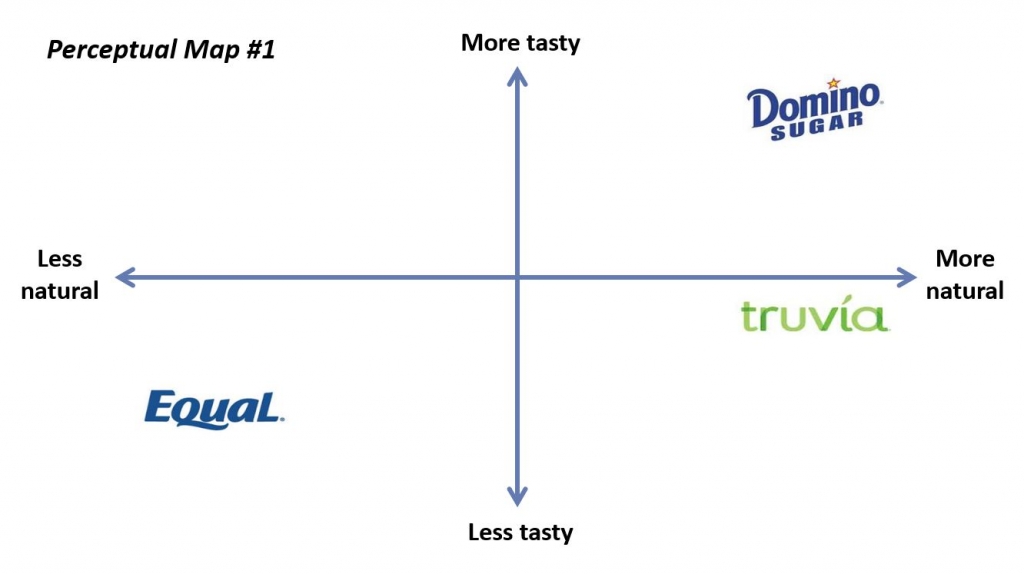There is a power to pictures – and that is the reason that perceptual brand mapping can be such an effective and efficient tool for marketers. Perceptual brand mapping is the visual plotting of specific brands against axes, where each axis represents an attribute that is known to drive brand selection. Because brand mapping creates such a concise summary of significant amounts of information, it has three key benefits for marketers.
#1: Unlocking insights about your competitors and industry

In its purest form, perceptual brand mapping shows the relative position of competing brands based on how those brands are perceived by consumers. The axes signify brand attributes that are known to be compelling to consumers and that also enable maximum differentiation among the brands. Here’s an example of a simplified map regarding beverage sweeteners.
The value of perceptual mapping is in the visual impact. Through this view of the marketplace, findings may come to light more quickly than they do with tables of data.
In this example, the perceptual map shows the “proximity” advantage that natural sugar substitutes (like stevia-based Truvia) have over artificial substitutes like Equal for acquiring sugar users who are seeking a healthier alternative. The implications of this advantage are major due to the sheer size of the sugar users segment, and the fact that artificial sweeteners like Equal may never be considered by many sugar users.
To do perceptual mapping right, it is best to create multiple mappings for your brand and the marketplace by using a few different sets of attributes that are important to the target audience. Here are another two simplified examples for beverage sweeteners.

 This exercise of generating multiple mappings can be fruitful because it requires evaluating your brand, competitors, and the marketplace through different lenses. These additional maps highlight further limitations for artificial sweeteners like Equal relative to natural substitutes like stevia-based Truvia in the eyes of sugar users.
This exercise of generating multiple mappings can be fruitful because it requires evaluating your brand, competitors, and the marketplace through different lenses. These additional maps highlight further limitations for artificial sweeteners like Equal relative to natural substitutes like stevia-based Truvia in the eyes of sugar users.
Ultimately, these are the types of learnings that can confirm specific brands’ strategies or strengths, and that can identify where an industry’s “sweet spot” or value may be located, as indicated on Map #3.
#2: Communicating where the brand is headed
In addition to surfacing learnings and insights, perceptual mapping can be an effective tool for describing a desired future position for a brand – especially when a brand is seeking to change its positioning or when an industry is undergoing a major shift. Understandably, a perceptual map can also help track the re-positioning of a brand over time as it moves towards that desired future position. Here is another sweeteners example.
In this example, a perceptual map shows the position that Equal wants to own – different from the position that it holds in consumers’ minds today. To that end, perceptual maps can be an effective tool for communicating brand strategy (or relevant changes) throughout the organization.
#3: Confirming alignment with your business and brand strategy
Another reason that perceptual mapping is useful for marketers is that the mappings can help gain alignment on strategy. A critical conversation to generate with perceptual mapping is whether a brand’s position is the right position, given the organization’s over-arching business strategy (e.g. vision, scope, advantages) and brand strategy (e.g. positioning, architecture).
Here are some of the key questions that a team must answer about a brand’s current and intended future position in the marketplace:
- Does this brand position align with the company’s strengths, assets, and capabilities?
- Does this brand position effectively express the unique value that we are offering?
- Is this brand position credible and compelling with consumers and customers?
- How sustainable and defensible is this brand position relative to competitors?
In the case of the Equal brand, the company validated the “natural” sweetener opportunity and aligned on the importance of competing in that space with brands like Truvia. However, ultimately they determined that a different brand strategy would be most effective with sugar users, launching a new “Naturals, from the makers of Equal” product line. This final map shows where they landed.
In conclusion, perceptual brand mapping can be an effective and efficient tool for marketers – yet it is an often overlooked tool in the marketer’s toolkit. Consider brand mapping as you seek to surface market insights, communicate brand direction, and ensure alignment of business and brand strategies.


Pingback: Brand Mapping: A Beginner's Guide to Building & Positioning Your Brand for Success - Oda Creative
Impressive write-up, I love this post. Thank you so much.
A great read. I’d love to hear how it goes as you get further along.
I have been surfing on-line greater than three hours today, but I never discovered any interesting article like yours. It is beautiful value enough for me. Personally, if all site owners and bloggers made excellent content as you probably did, the net shall be much more useful than ever before.
Pingback: The 2020 Guide to Successful Brand Positioning in Your Market | Timothy Vick
These are all great pieces of advice from a great person. Thank you for the post!